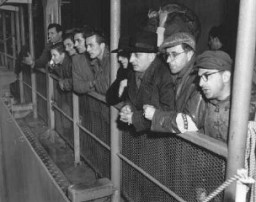You searched for: 购物返利源码快速搭建【TG���������@EK7676】平台包网搭建购物返利源码快速搭建【TG���������@EK7676】平台包网搭建9Eb2e2vuAK
<< Previous | Displaying results 51-75 of 299 for "购物返利源码快速搭建【TG���������@EK7676】平台包网搭建购物返利源码快速搭建【TG���������@EK7676】平台包网搭建9Eb2e2vuAK" | Next >>
-
Nazi Rule
SeriesThe Nazis took control of the police and turned Germany into a dictatorship; implemented a racist ideology; and carried out brutal policies across annexed and occupied Europe. Learn more.
-
Theresienstadt: Concentration/Transit Camp for German and Austrian Jews
ArticleLearn about the role of Theresienstadt in the deportation of German and Austrian Jews to killing sites and killing centers in the east.
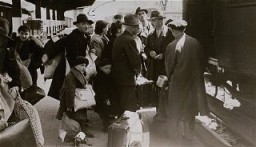
-
Supreme Court Decision on the Nuremberg Race Laws
ArticleLearn more about the 1936 German Supreme Court decision on the Nuremberg Race Laws.
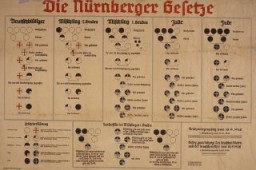
-
Melk
ArticleLearn about the establishment of and conditions in Melk, a subcamp of the Mauthausen camp system in Austria.
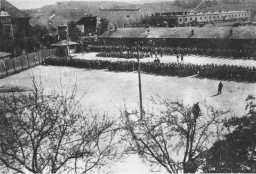
-
Operation Torch: The Anglo-American Invasion of French North Africa
ArticleOperation Torch was the Allied invasion of French Morocco and Algeria during the North African Campaign of World War II. Learn more.
-
The War Refugee Board
ArticleThe War Refugee Board was formed in 1944 by executive order under President Roosevelt. It was tasked with the rescue and relief of victims of Nazi oppression.
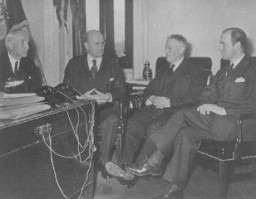
-
1938: Key Dates
ArticleExplore a timeline of key events in the history of Nazi Germany during 1938.
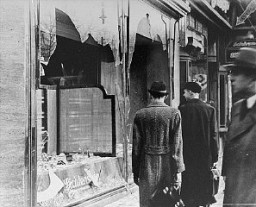
-
The Nuremberg Code
ArticleLeading German physicians and administrators were put on trial for their role during the Holocaust. The resulting Nuremberg Code was a landmark document on medical ethics. Learn more
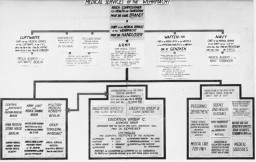
-
Adolf Hitler Becomes Leader of the Reestablished Nazi Party
Timeline EventFebruary 27, 1925. On this date, Adolf Hitler declared the reformulation of the Nazi Party with himself as the leader.
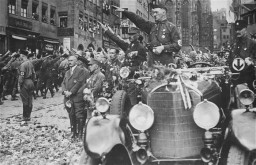
-
Desecrated Torah scrolls
ArtifactThese Torah scrolls, one from a synagogue in Vienna and the other from Marburg, were desecrated during Kristallnacht (the "Night of Broken Glass"), the violent anti-Jewish pogrom of November 9 and 10, 1938. The pogrom occurred throughout Germany, which by then included both Austria and the Sudetenland region of Czechoslovakia. The scrolls pictured here were retrieved by German individuals and safeguarded until after the war.
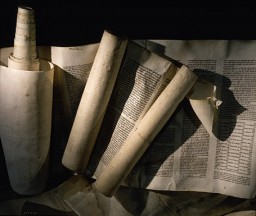
-
Pages of Hebrew prayer books damaged during Kristallnacht
ArtifactThe pages photographed here are from Hebrew prayer books destroyed during the Kristallnacht ("Night of Broken Glass") pogrom of November 9 and 10, 1938. These pages were damaged by fire during the destruction of the synagogue in Bobenhausen, Germany. The Jewish community of Giessen donated them to the United States Holocaust Memorial Museum in 1989.
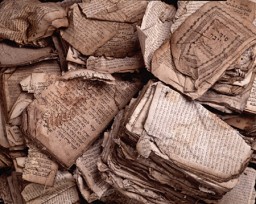
-
Portrait of Victoria and Isak Assael
PhotoPortrait of Victoria and Isak Assael, the daughter and son of Shabetai Assael. They were students and lived at Sremska 9 in Bitola. This photograph was one of the individual and family portraits of members of the Jewish community of Bitola, Macedonia, used by Bulgarian occupation authorities to register the Jewish population prior to its deportation in March 1943.
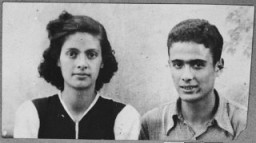
-
The judges at the Doctors Trial
PhotoAmerican judges (top row, seated) during the Doctors Trial, case #1 of the Subsequent Nuremberg Proceedings. Presiding Judge Walter B. Beals is seated second from the left. Nuremberg, Germany, December 9, 1946–August 20, 1947.
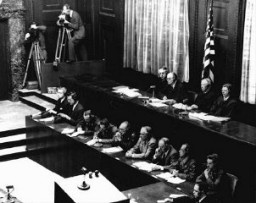
-
Otto Ohlendorf on trial
PhotoOtto Ohlendorf, commander of Einsatzgruppe D (mobile killing unit D), during Trial 9 of the Subsequent Nuremberg Proceedings. This photograph shows Ohlendorf pleading "not guilty" during his arraignment at the Einsatzgruppen Trial. Nuremberg, Germany, September 15, 1947.
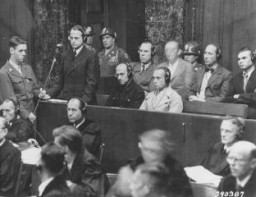
-
Jewish refugee ship Pan-York docks in Haifa
PhotoThe Jewish refugee ship Pan-York, carrying new citizens to the recently established state of Israel, docks at Haifa. The ship sailed from southern Europe to Israel, via Cyprus. Haifa, Israel, July 9, 1948.
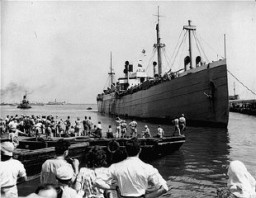
-
Insignia of the 95th Infantry Division
PhotoInsignia of the 95th Infantry Division. The 95th Infantry Division, the "Victory" division, gained its nickname from the divisional insignia approved in 1942: the arabic numeral "9" combined with the roman numeral "V" to represent "95." The "V" led to the nickname, since the letter "V" was universally recognized as an Allied symbol for resistance and victory over the Axis during World War II.
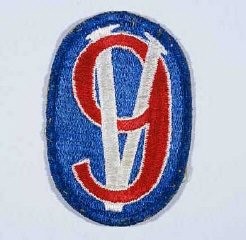
-
Dutch rescuer Semmy Woortman-Glasoog
PhotoSemmy Woortman-Glasoog with Lientje, a 9-month-old Jewish girl she hid. Woortman-Glasoog was active in a network which found foster homes, hiding places, and false papers for Jewish children. She was later named "Righteous Among the Nations." Amsterdam, the Netherlands, between 1942 and 1944.
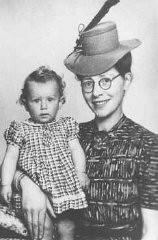
-
Synagogue in Oberramstadt burns during Kristallnacht
PhotoAs the synagogue in Oberramstadt burns during Kristallnacht (the "Night of Broken Glass"), firefighters instead save a nearby house. Local residents watch as the synagogue is destroyed. Oberramstadt, Germany, November 9-10, 1938.
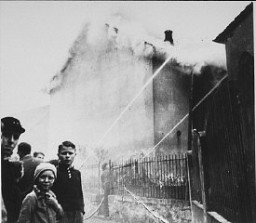
-
Retracing the route of the failed Beer Hall Putsch
PhotoAdolf Hitler, Julius Streicher (foreground, right), and Hermann Göring (left of Hitler) retrace the steps of the 1923 Beer Hall Putsch (coup). Munich, Germany, November 9, 1934.
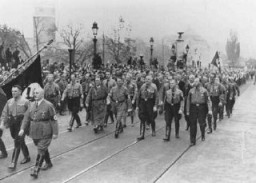
-
Celebration of the anniversary of Hitler's failed Beer Hall Putsch
PhotoAdolf Hitler and other participants in the Hitler Putsch, during the annual anniversary celebration of his failed attempt to seize power. Behind Hitler stand Rudolf Hess (left) and Heinrich Himmler. Munich, Germany, November 9, 1934.
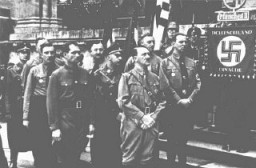
-
American soldiers pass through the main gate of the Mauthausen camp
PhotoSurvivors of Mauthausen cheer American soldiers as they pass through the main gate of the camp. The photograph was taken several days after the liberation of the camp. Mauthausen, Austria, May 9, 1945.
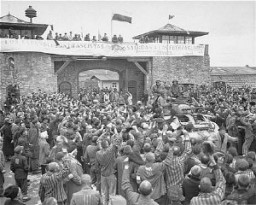
-
Antisemitism in History: Nazi Antisemitism
ArticleAntisemitism (hatred of Jews) predominated in Nazi ideology. The Nazis built upon centuries of anti-Jewish sentiment. Learn about antisemitism in Nazi ideology.
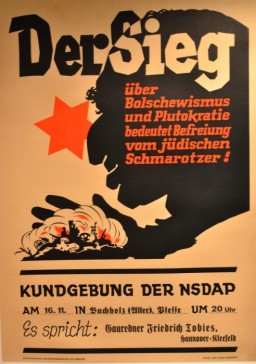
-
World War II in Eastern Europe, 1942–1945
ArticleBefore 1942, Nazi Germany had expanded across much of Europe. Learn more about major Allied victories in eastern Europe that led to the German surrender.
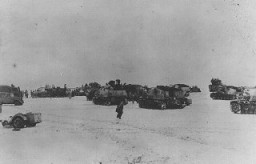
-
Oaths of Loyalty for All State Officials
ArticleThe Oath of Loyalty for All State Officials started to change in 1934. Learn more about the oath and Germany’s journey from democracy to a Nazi dictatorship.
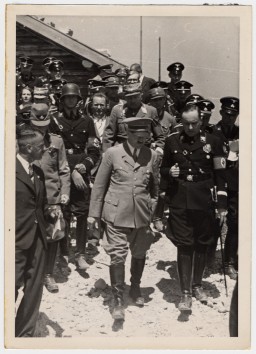
-
United Nations Relief and Rehabilitation Administration
ArticleThe United Nations Relief and Rehabilitation Administration’s mission was to provide economic aid to European nations and assist refugees after World War II.
